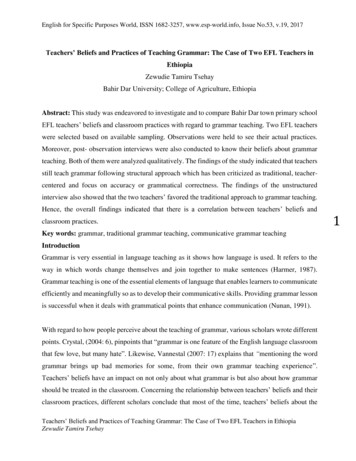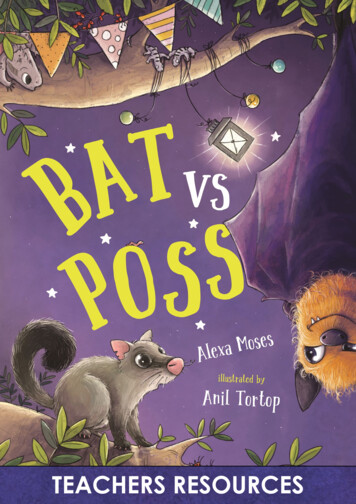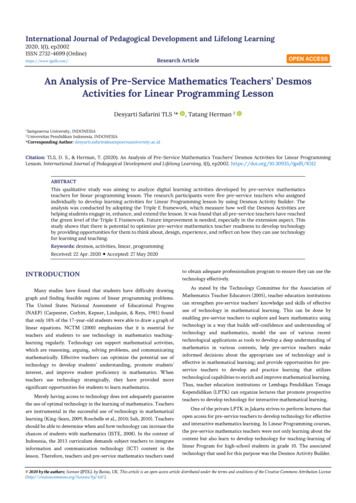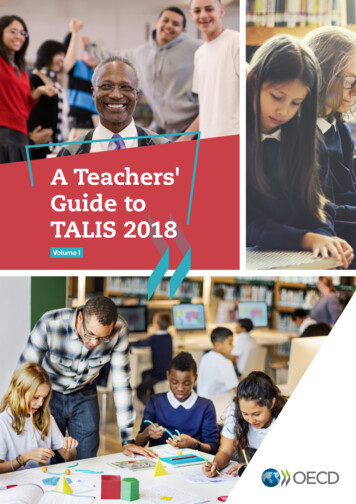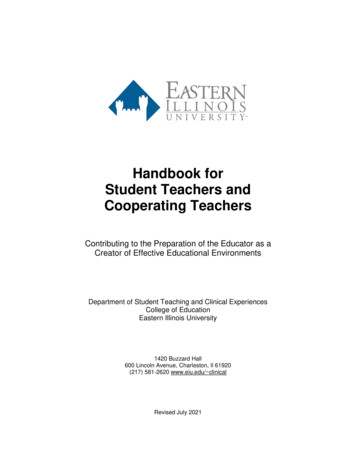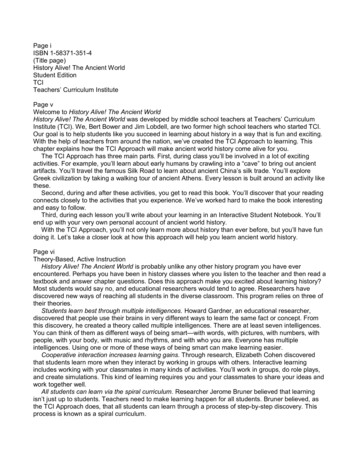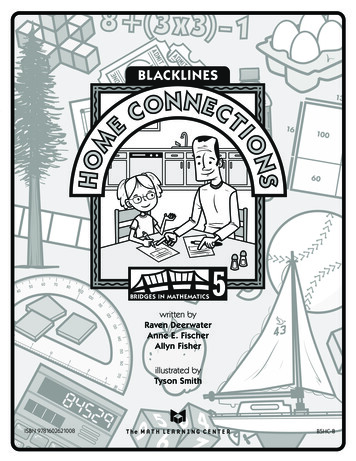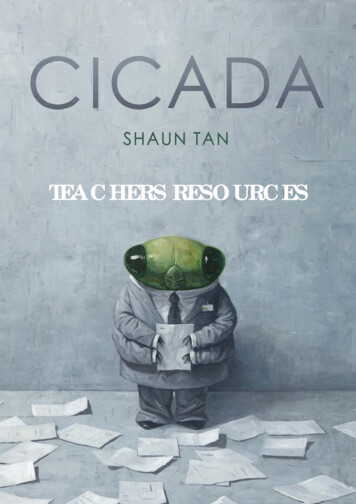
Transcription
TEACHERS RESOURCES1
CICADABY SHAUN TANTeachers Resources by Robyn Sheahan-BrightIntroduction4Before and After Reading the Picture Book5Themes5Curriculum Topics8Study of History, Society and EnvironmentEnglish Language and LiteracyVisual LiteracyCreative ArtsLearning TechnologiesFurther Extension Activities14Further Topics for Discussion and Research15Conclusion 152
Author/Illustrator’s Inspiration15About the Author/Illustrator19Activity Sheets21Bibliography24About the Author of the Notes263
INTRODUCTIONCicada tell story.Story good. Story simple.Story even human can understand.Tok Tok Tok!Back Cover TextCicada has worked for the company for seventeen years – always finisheswork perfectly; does unpaid overtime; is never offered promotion; has noaccess to office bathroom; sleeps in office wallspace; humans don’t likecicada; told to retire; climbs to top of building and .This stunning open-ended text is a philosophical exploration of the cultureof work but also of society. It traverses themes such as belonging, alienation, corporate bureaucracy and work, difference and prejudice, submission to control/freedom, transformation/metamorphosis, resurrectionand regeneration.Shaun Tan’s publisher describes the book as: ‘A dream of escape, a commentary on corporate slavery, a multi-layered allegory—Shaun has takenthe humble cicada and created a mythic fairytale of magic, menaceand wonder.’ Justin Ratcliffe, co-managing Director, Hachette B&P 15November 2017Shaun Tan is partly concerned here with Kafka’s nightmare of bureaucracy which, like many other concepts swirls together in a tantalising soup ofideas. For Tan’s images and words always defy categorisation. He relishesa sense of minimal control in his work – despite its intricate detail – andambiguity is a tool which allows him the freedom to ask open-endedquestions of relevance to every reader.4
BEFORE AND AFTER READINGTHE PICTURE BOOK What other books by Shaun Tan have you read and what impression doyou have of his style and interests as a writer and illustrator? What does the cover of Cicada suggest to you before/after reading thebook? Write a review of Cicada after you have read it.THEMESKEY QUOTE: Neil Gaiman: ‘I love your stuff because you’re never told whatthe emotion is. You get to feel it on your own and you get to discover theemotions along the way.’Shaun Tan: ‘With luck, it’s different for different people.’ (Gaiman, 2011)DISCUSSION POINT: Shaun Tan’s works are always suggestive of complexthemes and ideas about which he avoids making conclusive statements.He is interested in the human condition and in the social constructs withinwhich human beings operate. He explores the border between the realand the fanciful.Several themes are covered in this book which might be related to theAustralian Curriculum: BELONGING VERSUS EXISTENTIAL ALIENATION, ANGST & DISPLACEMENTDISCUSSION POINT: Cicada may seem to be the loneliest worker in theworld, but there are many workers and people in other situations who arejust like him. The melancholy images and the words in the book suggestimmense isolation and loneliness, and also cicada’s unspoken desire to fitin or belong.QUESTION: Does cicada finally belong?5
DISCUSSION POINT: Children will identify with this feeling of alonenessdespite the situation (workplace) and character (cicada) being differentto themselves. Shaun Tan’s work often deals with the theme of somethingbeing lost, or searching for meaning, and has related that to his ownchildhood memories.QUESTION: What ‘meaning’ does cicada discover? CORPORATE BUREAUCRACY AND WORKDISCUSSION POINT: The regimented office cubicles depicted mirror theregimented high rise buildings in cities (which are depicted on the frontendpapers). They are also suggestive of a ‘maze’ in which a person maybe lost and isolated. The walls are just high enough to obscure your fellowco-worker or neighbour from your eyes.QUESTION: What feelings do these cubicles arouse in the reader?DISCUSSION POINT: Cicada works extremely hard yet receives no recognitionand his working and living conditions are appalling. His dismissal is equallyso. The image in which he is cleaning his desk prior to leaving his job, withhis employer standing with crossed arms behind him, is physically chilling.This sort of exploitation is common even in wealthy companies. Tan invitesquestions rather than passing judgment.QUESTION: Why would cicada endure such a workplace? Why wouldhis employers treat him so badly? Are his working conditions typical ofcontemporary workplaces?DISCUSSION POINT: The barcode which appears on cicada’s nametagis also symbolic of the dehumanisation of people in such anonymousworkplaces.QUESTION: What damage does taking a person’s name from them do tothem emotionally? In what places are names erased from people?DISCUSSION POINT: A faceless man from ‘Human Resources’ appears intwo frames in the book; his job is to deal with cicada’s employment anddismissal.QUESTION: Is this an accurate portrayal of the manner in which humanresources departments often treat people? What evidence do you baseyour answer on?6
DIFFERENCE AND PREJUDICEDISCUSSION POINT: Cicada is looked down upon by co-workers because‘he is not human’. They ignore him and he is forced to use a bathroomtwelve blocks away.QUESTION: Prejudice towards those who are supposedly different (by virtueof race, religion, colour, disability etc) still exists in many workplaces despiteprograms to ensure it doesn’t. Why are people so ready to reject those whoare different?DISCUSSION POINT: In one grim scene cicada is being physically molested.Such office bullying is also reminiscent of the bullying allowed in someschools and universities called ‘hazing’.QUESTION: Why is physical violence such a common expression of prejudiceor insecurity? SUBMISSION TO CONTROL VERSUS RESISTANCE TO CONTROL/FREEDOMDISCUSSION POINT: This book contrasts two ways of looking at the world –submission to control or freedom. The latter may involve either passive oraggressive resistance to control.QUESTION: Cicada is a virtual prisoner in his workplace, but by the end ofthe book cicada is free. How does he achieve that?QUESTION: Might freedom also be likened to escape? MATURING & PROCESSING EXPERIENCEDISCUSSION POINT: Cicada has watched and processed his observationsof the people around him for seventeen years.QUESTION: What has he finally decided or discovered about his colleaguesand about himself? TRANSFORMATION /METAMORPHOSISDISCUSSION POINT: Franz Kafka’s classic novella The Metamorphosis (1915)had a travelling salesman turn into a giant insect. Here the drab greencicada sheds his shell and becomes a bright red flying insect.7
QUESTION: What does physical transformation/metamorphosis suggestmetaphorically? RESURRECTION AND REGENERATIONDISCUSSION POINT: The final images in the book might be likened not just totransformation but also to the hope of resurrection or regeneration.QUESTION: What is cicada’s likely future? Is it a new life?CURRICULUM TOPICSTeachers might relate this text to the following curriculum areas:STUDY OF HISTORY, SOCIETY AND ENVIRONMENTAny of the themes above might relate to the HSE curriculum areas such as: WorkplacesSocietal ControlRelationshipsEnvironment and Urban DensityENGLISH LANGUAGE AND LITERACYKEY QUOTE: ‘I use text as grout in between the tiles of the pictures. I alwaysoverwrite, really awful, long bits of script and then I trim it down to the barebones and then add a little bit to colour it in. At the end of all of my storiesI test for wordless comprehension. So I remove the text and see if it worksby itself. And if it does I feel that that’s a successful story. I don’t know ifthat’s an important principle but it’s helped me structure things. (ShaunTan, quoted, Gaiman 2011)The text of this book might be studied in relation to: NARRATIVE PERSON & TENSEDISCUSSION POINT: This text is written in third person, present tense whichmakes the telling of the story very arresting.8
QUESTION: Why isn’t the text written in first person, given that it is cicada’sstory?QUESTION: If it had been told in past tense how would that have alteredthe telling? SYMBOLISMDISCUSSION POINT: ‘Cicadas have been featured in literature since thetime of Homer’s Iliad, and as motifs in art from the Chinese Shang dynasty.They have been used in myths and folklore to represent carefree living andimmortality Cicadas are a frequent subject of haiku, where, dependingon type, they can indicate spring, summer or autumn’ WikipediaIn Ancient China, members of wealthy families would insert a jade carvingof the cicada inside the mouth of their deceased loved one before buryinghim or her. They believed that this would ensure that the deceased wouldhave a joyful life after death, and give them immortality.QUESTION: Why do you think Shaun Tan used a cicada as the character inthis book?QUESTION: Is the theme of mortality significant in this book? LITERARY DEVICES & LANGUAGEDISCUSSION POINT: The language used here is spare and cryptic. It might beinterpreted as being suggestive of the cryptic office language encouragedby writing memos, emails and short posts on social media. But it mightalso be suggestive of the dehumanising of cicada in this emotionless andheartless workplace. The repeated phrase ‘Tok Tok Tok’ is also suggestiveof the clock being continuously watched in corporate offices.QUESTION: What did the style of language suggest to you? GENREDISCUSSION POINT: This story has been described as an allegory whichis a story, poem, or picture that can be interpreted to reveal a hiddenmeaning, typically a moral or political one.QUESTION: In what way is Cicada an allegory?9
HUMOURDISCUSSION POINT: Despite the grim subject matter there is always a senseof irony and whimsy in Shaun Tan’s words and images.QUESTION: What sort of humour is prevalent in the text? WRITING TASKSACTIVITY: This poem appears on the imprint page of this book:calm and serenethe sound of a cicadapenetrates the rockMatsuo Bashō (1644–94)trans. Yuzuru MiuraInvite students to write a haiku poem in response to this picture book. Haikuis a Japanese form of poem which consists of 3 lines; the first and last lineshave 5 syllables and the middle line has 7 syllables. (The lines rarely rhyme.)[See Activity Sheet 1.]ACTIVITY: Write an acrostic poem using the letters in CICADA. [See ActivitySheet 1.]ACTIVITY: Invite students to write a tectratys poem in response to this picturebook. A tetractys is a five-line poem with 1, 2, 3, 4, 10 syllables in each line.ACTIVITY: Re-write the story as an expository piece of writing such as anewspaper article about cicada’s situation.VISUAL LITERACYThe visual text of a book combines with the written text to tell the story usingthe various parts of the book’s design and illustrations, as explored below:10
PARTS OF THE BOOKDISCUSSION POINT: The cover of a book is an important part of its message.This depicts cicada standing centre staring at the reader, holding a pieceof office paper with pieces of other office documents scattered on thefloor around him. The contrast between his neat attire and unemotionaldemeanour with the loss of control of these memos, hints at the twinconcepts to be contrasted in the book.DISCUSSION POINT: The endpapers offer another contrast. The frontendpapers depict shapes synonymous with the high rise banality of innercity corporate office buildings. They are grey and indistinguishable fromeach other. The back endpapers depict a lush colourful landscape alivewith plants and wildlife. This represents a metaphorical return to nature.DISCUSSION POINT: The title page is followed by a wordless double pagespread showing the cicada’s upper torso with his nametag attached. Hisinsect arms poking from the suit jacket are arresting. The size of the imageis also imposing.QUESTION: What does this image suggest to you?DISCUSSION POINT: The format of the book is portrait, rather than landscapeor square. Why?QUESTION: How does the layout of the storyboard and the format anddesign of the pages influence your reading of it?DISCUSSION POINT: The resolution of a narrative always involves a turningpoint. In this text the turning point hinges on cicada’s transformation andflight from the roof of his office building. OPEN ENDINGS AND AMBIGUITYDISCUSSION POINT: The image of cicada teetering on the edge of the officebuilding’s roof is frighteningly real. It is suggestive of possible suicide, but istransformed into an uplifting moment of escape; but it might also suggesta dream of a hopeful ending. It is one of a series of five wordless images,followed by a white page with a few final words.QUESTION: Ask your students to respond to this series of wordless images.How did they interpret each one of them?11
PERSPECTIVEDISCUSSION POINT: The humans in the images are depicted as figureswithout faces either facing away from the viewer or seen only as parts oftheir torsos. This cements the theme of dehumanising alienation in corporateoffices. CHARACTERDISCUSSION POINT: Creating characters generally entails studying facialexpressions and body language. Only cicada’s face is seen in this visualtext. Describe cicada’s character from the clues in words and images.QUESTION: Choose a frame. What does the body language indicate aboutthe human depicted? MEDIUM AND STYLEACTIVITY: Every aspect of the drawing and painting relates to the thematicwhole. The medium employed is oil and acrylic on paper in a naturalisticstyle.QUESTION: What else did you observe in Tan’s style of art?DISCUSSION POINT: The colours are drab grey with only the green of thecicada visible, until the final transformative images of red cicadas flyingaway. SETTINGDISCUSSION POINT: Geometric shapes of squares and rectangles (buildings,office cubicles, stairs) give a thematic unity to the images. Invite studentsto compare these to geometrical images created by other artists such asM.C. Escher, and discuss. INFLUENCES ON SHAUN TAN’S WORKDISCUSSION POINT: Tan delights in creating creatures with distinctcharacteristics. His books portray a gallery of outlandish creatures who areoften an amalgam of the real and the fanciful. Although cicada is an insecthis eerie depiction has similarities to the sci-fi conventions which are oftenthe subject of Tan’s images. Tan spent his early working life illustrating scifi magazines, the film ET (1982) was an influence, as was George Orwell’s12
novel Animal Farm (1945) so that dystopian imagery is prevalent too.QUESTION: What visual or literary references have you unearthed in thistext? CRITICAL LITERACYTan’s work encourages reflection and develops critical literacy.ACTIVITY: Invite students to engage with any page in this book and then todescribe what it ‘says’ to them; how it makes them feel.ACTIVITY: Interrogate each image and find any ‘hidden’ or less obviousdetails in them. For example, ‘read’ the image of cicada trying to reachthe lift button in order to visit a bathroom twelve blocks away. ILLUSTRATION TASKSACTIVITY: Invite students to draw, paint, or collage another scene to furtherillustrate the ideas suggested in this story. [See also Activity Sheet 2.]ACTIVITY: Choose an image in the book, and re-draw it as a cartoon. Createa caption to go with your cartoon.ACTIVITY: Design a new cover for the book. CREATIVE ARTSThere are many creative activities suggested by this text:1. Create a mural of the city as it is depicted on the front endpapers of thisbook.2. Create a model of cicada from materials such as fimo clay, foil, fabric ora combination. [Note: See the models created for the illustrations in Tan’sThe Singing Bones.]3. ACTIVITY: Create a graphic novel version of a scene in this book. [SeeBibliography and Activity Sheet 3.]13
4. Create a poster to advertise this book.5. Create a Book Trailer to promote this book. [See Bibliography.]6. Create a similar kind of story set in a school environment; substitute astudent with an animal, and play it out to see what happens. The themecould be anything, not just subjugation, eg. The butterfly who attractstoo much attention, the bull who can’t control his temper, the songbirdwho gets by on mimicry alone, until called to account. There are endlesspossibilities, and using animal substitutes actually makes the creativeprocess so much easier. Shaun Tan says that: ‘The Lost Thing is very mucha precursor to Cicada in this respect, and there are strong parallels. I tendto deal with issues of solitude, but the central issue of ‘difference’ couldappeal to students with more social dilemmas in their lives. In short, I’dencourage creative activities to move beyond my own stylistic imagery,and understand the fundamentals of this kind of storytelling.’ LEARNING TECHNOLOGIESACTIVITY: Research the topics above online.ACTIVITY: Research the work of the author/illustrator online. [SeeBibliography.]FURTHER EXTENSIONACTIVITIES1. Discuss themes above such as ‘existentialism’ or ‘freedom’ and thenread other picture books which deal with these topics and compare toCicada. [See Bibliography.] Create a classroom display of books on thesethemes.2. Make a list of questions you have about this book and its meaning.Share them with your class and discuss possible answers.3. What music might accompany this text if you were to dramatise it?4. Conduct a debate about any of the social issues raised in this book.5. Write a blurb summarising and promoting this book.14
FURTHER TOPICS FORDISCUSSION AND RESEARCH Research the work of Shaun Tan. Compare Cicada to his other books. Investigate any other topic not covered in these notes which youconsider is suggested by this text.CONCLUSIONCicada is a deeply moving allegory of a life indentured to the corporateworld until freedom is achieved. It is also a work about belonging andacceptance of others. It’s about how one can be imprisoned byexpectations. It’s about maturing and finding one’s place in the world. It’sa metaphor for self-affirmation, escape and hope.AUTHOR/ ILLUSTRATOR’SINSPIRATIONNotes on CICADA, Shaun Tan, March 2018‘The earliest idea for Cicada came during a visit to Berlin around 2005(although it could have been any time in any city) and looking at an imposinggrey office building with hundreds of identical grey windows. In one ofthese windows, someone had put a bright red flowering plant. I rememberjoking to a friend that maybe a big insect, a bee or something, workedin that cubicle. It was a thought I recalled subsequently whenever I sawsomething organically out-of-place in the otherwise sterile environment ofcorporate office spaces: a particularly lonesome pot plant, an employer’scat or dog, a lost sparrow. Interesting observations, but not really any ideathere for a story. A good story always needs a second, third or even fourthunrelated element to gain traction in the imagination.One such element came from hearing cicadas outside my bedroomwindow, and sometimes finding their empty casings – the cast-off skin ofthe nymph – still clinging to a high wooden fence (there are large lime15
green cicadas in Melbourne that I’d rarely seen in Perth, where I previouslylived). Elsewhere I’d seen a documentary about the life cycle of somecicadas, in which they spend up to 17 years underground before emergingall at once, overwhelming their predators, then mating and dying in abrief glorious period. It seemed like a kind of heightened awareness oflife, compressed into a very short final act. This life cycle is very alien to ushumans, but it’s interesting that we still find it fascinating, as if there is somemetaphor here about mortality, investment and endurance.(above: comic panel from A day in the life, 2011, and a personal sculpture‘Cicada officium’ 2012. My interest in a suited cicada has surfacing onand off over the past decade.)A third, more subconscious influence might be traced to anecdotes fromfriends, as well as news stories, about the disillusionment of workers withinlarge corporations and other businesses. I think my father might be includedhere, having worked for an architectural firm in which long years of workand loyalty went largely unacknowledged. A friend with a long careerin one of the bigger tech firms retired feeling quite bitter at the wasteddecades of devoted service in a company that in the end did not valuehim highly. I was also influenced by dreadful reports of a tech factory inChina that installed ‘suicide nets’ around their buildings to prevent workersfrom jumping to their deaths. Corporations sometimes sustain the illusion ofhaving primarily human interests – the welfare of workers and customers– when those interests are frequently secondary to far more abstractfinancial ones. The 2003 Canadian documentary The Corporation presentsthe interesting and compelling view of corporate entities as pathologicalin this regard, a problem of how they are legally defined and politicallyempowered. I’ve always been interested in the ways that social, politicaland economic structures, originally created to promote human interests,can actually end up being very dehumanising. We are easily enslaved bythe very systems that are meant to work for us, and morally influenced bytheir logic. I suspect these systems encourage us towards further ethical16
compromises by confusing our judgment of value. From faking budgetforecasts to workplace bullying, institutional structures often facilitate aslippery scale of moral apathy and transgression, things we are all capableof.Works of art and literature are also necessary influences for any story, nomatter how small. Kafka’s The Metamorphosis (1915) of course, although Ionly noticed the parallels with Gregor Samsa, the salesman who wakes upone day as a giant bug, quite late in developing my own story, but it’s alwaysbeen one of my favourite surrealist tales. George Orwell’s Animal Farm(1945) continues to be an influence, as well as 1984 (1949); Terry Gilliam’sfilm Brazil (1985), not unlike a comedic version of 1984 also continues toinspire Cicada as it did my picture book and short film The Lost Thing. Thereare several Gary Larson cartoons about big bugs that have always amusedme, and one in particular about a high-flying executive insect who is nowhomeless because a co-worker one day pointed out ‘Hey, he’s just a bigcockroach!’ I would also have to cite both the British and US versions of themockumentary sitcom The Office (2001-2013) as influences; Mike Judgecomedy Office Space (1999), and Jacques Tati’s visual critique of 1960sliving and work spaces in Playtime (1967), a period when these kind ofhuman aquariums must have been relatively new. Interestingly, I’ve neverin my life worked in an office cubicle of for a large company, and perhapsthis is one reason I find these environments fascinating, both visually andnarratively. They are like the science fiction sets of a movie made a longtime ago: a movie that might be either utopian or dystopian – it’s hardto tell! I find them both attractive and unsettling, and that’s the kind ofambivalent feeling that typically inspires me to write and draw stories.The visual development of Cicada is also influenced by my experience withtheatre and film production, of how you can tell a story with minimal propsand sets. For Cicada, I began by sketching out thumbnails of differentpossible incidents involving an insect working uncomfortably alongsidehumans. Instead of developing these as more detailed drawings, asI usually do, I made a sculpture of the central cicada character withmoveable limbs – basically an action figure – and built simple miniatureoffice spaces out of paper and board. I could then arrange and lightthese elements on a table-top, photograph them, and use the resultingimages as ‘sketches’ for both structuring the story and as reference for finalpaintings. In some cases, the finished illustrations are nearly identical to thephotographs, and shows how useful this process can be in exploring scenevariations, not unlike film-making. I’d liken it to stop motion animation, onlywithout the animation.I thought about having the entire book as photographed puppets andsets, but there is something about the transition to oil-painting, particularly17
with loose strokes, that gives each scene an otherworldly quality, and thescale of the world seems larger in the imagination. It also makes it easier toblend together those scenes that are very difficult to fabricate physically– the forest, long stairwells and so on. The human figures are based onphotos of myself posing in a suit, both bossing and bullying the cicada,which could be then be grafted into paintings by matching the lightingeffects.Left: a cicada sculpture photographed within a cardboard set, thendigitally edited, forming the basis for the final painted illustration (right)where more detail has been added.What is the resulting story about? Well as usual that is a question for thereader. My own interpretation has changed during the long period I’vebeen thinking about Cicada, and then creating final illustrations andtext, which tend to exert their own pressures and ideas. That is, I listen towhat the story seems to be telling me to do, work on getting it right, andthen speculate more deeply about meaning later (like now). I also try tokeep it very simple. I used to think this story was mostly about workplacebullying, and this was the emphasis in early notes, research and extensivestoryboards. But the part I mostly think about now is the fact that the cicadais amused by humans the whole time, but we only know that his signaturerefrain ‘Tok! Tok! Tok!’ is the sound of laughter at the very end. Maybe thestory is less about corporate slavery than the power of personal attitudeor direction. That is, the same situation – especially one in which you aretrapped – can be depressing or amusing depending upon how you lookat it, react to it, or think beyond it. It could be that all throughout its officelife, the cicada is so enthralled by the idea of returning to the forest thatany time among humans is merely amusing and inconsequential, even18
fascinating. The cicada has a very different perspective on time, purposeand liberty, and this is one possible interpretation of the Basho haiku Idecided to include at the end of the book.Calm and sereneThe sound of the cicadaPenetrates the rockOf course, we never know how the cicada is really feeling. We assume thisunderappreciated employee must be miserable, but we may be mistaken.The other side to this thought is to wonder about the office environmentof the story, or any institution populated by uncaring, aggressive andbasically unhappy humans, and think about the ultimate purpose of it.Who is really enduring these absurd conditions? Not the cicada: it alwayshas something greater to look forward to.’ABOUT THE AUTHOR/ILLUSTRATORShaun Tan grew up in the northern suburbs of Perth, Western Australia. Inschool he became known as the ‘good drawer’ which partly compensatedfor always being the shortest kid in every class. He graduated from theUniversity of WA in 1995 with joint honours in Fine Arts and English Literature,and currently works full time as a freelance artist and author in Melbourne.Shaun began drawing and painting images for science fiction and horrorstories in small-press magazines as a teenager, and has since become bestknown for illustrated books that deal with social, political and historicalsubjects through surreal, dream-like imagery. Books such as The Rabbits(1998), The Red Tree (2001), Tales from Outer Suburbia (2008) and theacclaimed wordless novel The Arrival (2007) have been widely translatedand enjoyed by readers of all ages. Shaun has also worked as a theatredesigner, and worked as a concept artist for the films Horton Hears aWho and Pixar’s WALL-E, and directed the Academy Award winningshort film The Lost Thing with Passion Pictures Australia. The Rabbits wasmade into an opera with Opera Australia in 2015 and several books havebeen dramatised as plays. His latest works include The Bird King and otherSketches (2010), The Singing Bones (2015) and Rules of Summer (2016). Thisyear he will also publish Tales from the Inner City (A&U). In 2011 he receivedthe prestigious Astrid Lindgren Memorial Award, honouring his contribution19
to international children’s literature and was presented with the DromkeenMedal for Services to Children’s Literature in Australia. His other awards arenumerous: a selection includes CBCA Picture Book of the Year 1999 for TheRabbits; Honour Book, CBCA Picture Book of the Year 2000 for Memorial,2001 for The Lost Thing and 2002 for The Red Tree; CBCA Picture Book of theYear 2007 for The Arrival and both the NSW and Western Australia Premier’sBook Awards 2006 and 2007 respectively; CBCA Picture Book of the Year2014 and shortlisted for the CILIP Kate Greenaway Medal for 2015 for Rulesof Summer.Visit his website: http:// www.shauntan.net 20
ACTIVITY SHEET 1.POETRY ACTIVITIESHAIKU POEMACROSTIC POEMCICADATETRACTYS POEM21
ACTIVITY SHEET 2.DRAW THIS IMAGESee preliminary sketch for cicada, drawn by Shaun Tan, below. Studentsare invited to draw their own original ‘animal-worker’ on the right. Indoing so, invite them to pay attention to the three-quarter angle of thepose, which is the ideal way of drawing a concept character or portrait,because you get a fuller sense of what the subject looks like in the round.The suit is also a tricky thing to draw, but easy to copy, with only head,hands and feet requiring most improvisation.22
ACTIVITY SHEET 3.DESIGN A GRAPHIC NOVELPAGECreate a graphic novel/comic interpretation of one of the scenes in thisbook. Use any of the layouts below as the storyboard for your comic.Enlarge to A3 on a photocopier to give you more space.Layouts taken from Comic Book Guide age/2/ 23
BIBLIOGRAPHYPicture BooksGleeson, Libby The Great Bear Ill. by Armin Greder. Scholastic,1999.G
At the end of all of my stories I test for wordless comprehension. So I remove the text and see if it works by itself. And if it does I feel that that’s a successful story. I don’t know if that’s an important principle but it’s helped me structure things. (Shaun Tan, quoted, Gaiman 2011) The t

